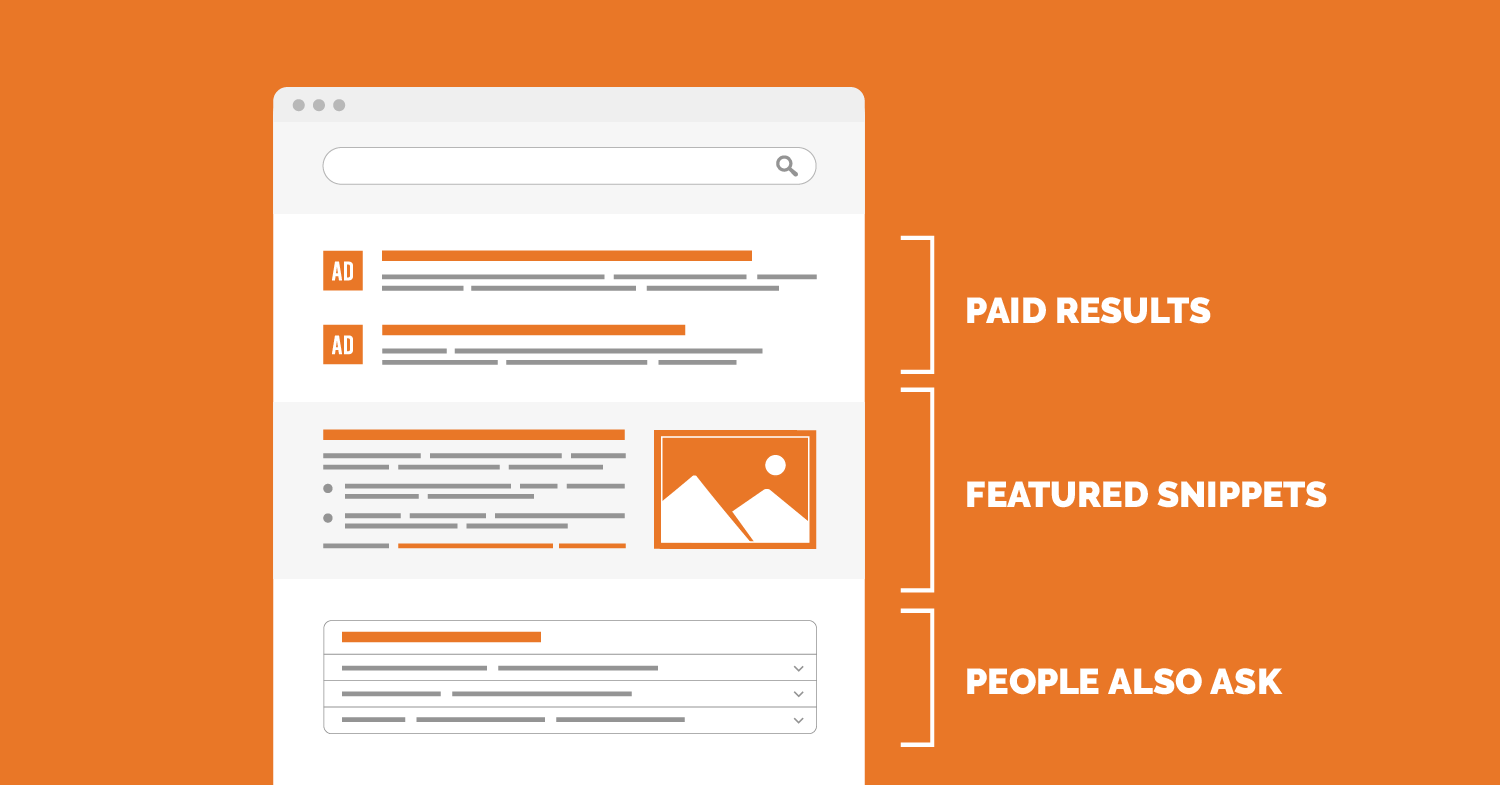Google’s search engine results page (SERP) features, including elements like featured snippets and local packs, have reshaped the digital marketing landscape. These features offer new opportunities for visibility and user engagement. For instance, a well-optimized featured snippet can position your website as a trusted authority and local packs can drive both online and foot traffic for businesses with a physical presence.
However, these features also introduce challenges, such as “zero-click searches,” where users get their answers directly on the SERP, reducing the need to visit a website and potentially decreasing organic traffic. Navigating this landscape requires understanding how to optimize for Google’s SERP features and adjusting your search engine optimization (SEO) strategy accordingly. Despite the challenges, these features offer exciting opportunities for those who can effectively leverage them, leading to increased visibility, user engagement, and conversions.
Understanding the Impact of SERP Features
Google’s mission is to provide users with the most relevant information for their queries in the quickest possible way. As a result, SERP features have been introduced, which can significantly reduce the overall number of clicks to sites, including your own, unless you happen to be featured in one.
What Are SERP Features?
SERP features are special results that appear on Google’s search engine results pages. They are designed to provide users with the most relevant information for their queries quickly and efficiently. These can include:
- Google Ads
- Images
- Local Pack
- Videos
How Do SERP Features Affect My Website?
SERP features can significantly impact your website’s organic traffic. When your site isn’t featured in one of these SERP features, you might see a noticeable decrease in the number of clicks your site receives. On the other hand, if your site is featured in a SERP feature, it could increase organic traffic.
Identifying a Loss of Traffic
Before you can recover lost traffic, you first need to identify the source of the loss. There are several potential causes of a drop in traffic, including:
- Drop in ranking: If your website’s ranking on SERPs drops, your visibility to potential visitors decreases, leading to a drop in organic traffic.
- Drop in clicks: A decrease in the number of clicks your website receives can signify reduced visitor interest or engagement.
- Increase of a SERP feature: The introduction or increase of a SERP feature can significantly impact your site’s organic traffic.
How to Track SERP Features
Tracking SERP features is crucial in understanding their impact on your website’s traffic. You can use SEO tools like Moz’s SERP features report, SEMRush, or Ahrefs to monitor the SERP features for your targeted keywords.
Analyzing Which SERP Features Are Causing Issues
Once you’ve identified a traffic loss, the next step is determining which SERP features are causing the problem. Here’s a closer look at some of the main culprits:
Google Ads
Google Ads appear at the top of the SERP, above organic listings. They’re highly visible and can significantly reduce the clicks your site receives, particularly for transactional queries.
Images
Image packs can take up a significant portion of the SERP. If your site isn’t included in the image pack for relevant queries, you could lose out on potential traffic.
Local Pack
The local pack feature displays local businesses related to the search query. If your business isn’t included in the local pack for relevant local queries, you’re likely missing out on significant local traffic.
Video
Video results appear prominently on the SERP and can attract a lot of clicks. If your site doesn’t have video content, you might miss out on this potential traffic source.
Additional Factors Causing Traffic Decreases
While SERP features are a significant factor, it’s essential to consider other potential causes for a drop in traffic. These can include:
- Resetting ‘post-COVID’ traffic expectations: The COVID-19 pandemic has significantly impacted online behavior. As the world gradually returns to normal, you might see changes in your website traffic.
- Seasonality: Seasonal trends can significantly impact certain businesses. If your company is affected by seasonality, expect fluctuations in your website traffic.
- Diversification of selling platforms: If you’re selling your products or services on multiple platforms, you might see a decrease in your website traffic as customers use these other platforms.
- Economic concerns: Economic uncertainty can lead to changes in consumer behavior, potentially impacting your website traffic.
How to Compete for Position Zero
Position zero, also known as the featured snippet, is a highly coveted spot on the SERP. It appears above the organic search results and can significantly increase your site’s visibility. Here’s how to optimize for position zero:
Focus on Keyword Intent
Understanding the intent behind your target keywords is crucial. Make sure your content aligns with the search intent of your target audience.
Accelerated Mobile Pages (AMP)
AMP is a Google-backed project aimed at speeding up the loading time of webpages on mobile devices. Implementing AMP can improve your site’s mobile performance and potentially boost your SERP rankings.
Add Schema for Featured Snippets and PAA Boxes
Schema markup helps Google understand the content of your page, increasing your chances of appearing in featured snippets and PAA (People Also Ask) boxes.
Local Packs
Optimizing your Google Business Profile (formerly Google My Business) listing can increase your chances of appearing in local pack results. Ensure your contact and address information is accurate, and encourage customers to leave reviews.
Paid Advertising
While it might seem counterintuitive, paid advertising can actually help boost your organic traffic. By bidding on your target keywords, you can increase your visibility on the SERP and potentially drive more traffic to your site.
Google Shopping
If you’re an eCommerce business, consider setting up a Google Shopping campaign. Like paid advertising, this can increase your visibility and drive more traffic to your site.
Knowledge Panels and Carousels
Knowledge panels and carousels can significantly impact your traffic. While it’s challenging to appear in a knowledge panel, you can increase your chances by providing high-quality, authoritative content.
How to Rework Your Strategy and Regain Traffic
If you’ve identified SERP features as a significant factor in your traffic loss, it’s time to adjust your SEO strategy. Here are a few things to consider:
Understand Your Audience
Knowing your audience and understanding their search intent is crucial in crafting an effective SEO strategy. Make sure your content marketing efforts aligns with your audience’s needs and expectations.
Optimize for SERP Features
Optimizing for SERP features can help you regain lost traffic. This involves understanding which features impact your traffic and implementing strategies to take advantage of these features.
Create High-Quality Content
High-quality content is key to ranking well on SERPs and attracting organic traffic. Ensure your content is relevant, engaging, and valuable to your audience.
Implement Technical SEO
Technical SEO aspects like site speed, mobile optimization, and structured data can significantly impact your site’s visibility on SERPs. Ensure your site is technically sound to improve your chances of ranking well.
Need Help? Contact ZGM for Your Digital Marketing Strategy
Are you experiencing traffic loss due to SERP features? The experts at ZGM are here to help. With our comprehensive digital marketing strategies, we can help you optimize for SERP features and regain your lost traffic. Contact us today to learn more.
FAQs About SERP Features
What are SERP features?
SERP features are special results that appear on Google’s search engine results pages. They are designed to provide users with the most relevant information for their queries quickly and efficiently.
How can I improve my SERP features?
Improving your SERP features involves understanding which features impact your traffic and implementing strategies to take advantage of these features. This can include optimizing your content for featured snippets, implementing AMP, and optimizing your Google Business Profile listing for local pack results.
What is a good click-through rate?
A good click-through rate (CTR) can vary depending on your industry and the type of content you’re promoting. However, a CTR above 2% is generally considered good.







